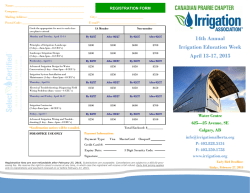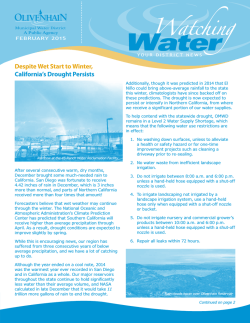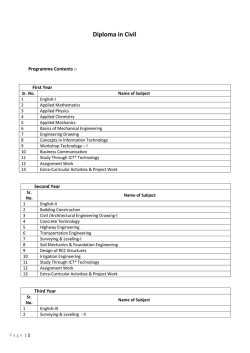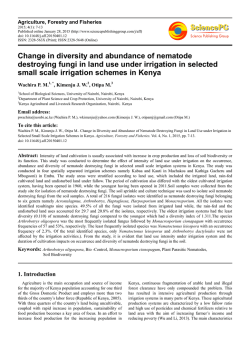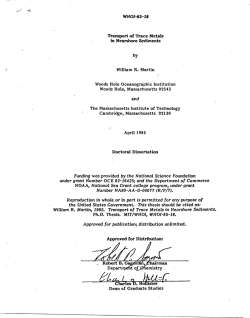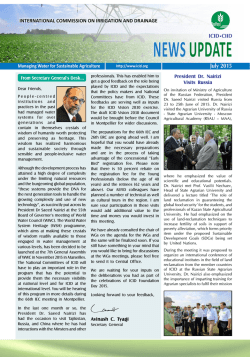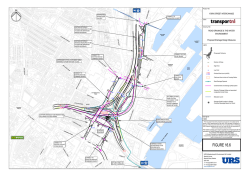
Water Management
WATER RESOURCES MANAGEMENT – Vol. II - Water Management - Emmanuel Mapfumo, David S. Chanasyk WATER MANAGEMENT Emmanuel Mapfumo and David S. Chanasyk University of Alberta, Canada Keywords: Water, irrigation, aquifer, soil, salinization, hydrology Contents U SA NE M SC PL O E – C EO H AP LS TE S R S 1. Importance of Water and Its Global Distribution 1.1. Availability of Global Water Resources 1.2. Importance of Water to Plant Growth 2. Cropping Systems for Sustainable Water Use 3. Irrigation 3.1. Definition and History 3.2. Irrigation as a Management Practice 3.3. Irrigation Agronomy 3.4. Irrigation Engineering 3.4.1. Surface Irrigation Methods 3.4.2. Sprinkler Irrigation 3.4.3. Trickle Irrigation 3.4.4. Subsurface Irrigation 3.5. Irrigation Water Management 3.5.1. Quality 3.5.2. Removal of Excess Salts from Irrigation Water 3.5.3. Efficiency of Water Use 3.5.4. Global Irrigation Efficiencies Trends 3.5.5. Community-Based Irrigation Management 4. Drainage 4.1. Definition 4.2. Sources of Excess Water 4.3. Drainage Benefits 4.4. Environmental Impacts of Drainage 4.4.1. Acid Mine Drainage 4.4.2. Subsidence of Organic Soils 4.5. Surface Drainage Methods 4.5.1. Bedding Systems 4.5.2. Open Ditches 4.6. Subsurface Drainage Methods 4.6.1. Drainage Methods for Water Table Control 4.6.2. Drainage Methods for Soils of Low Permeability 4.7. Drainage Design Parameters 4.8. Drainage Equations 5. Degradation of Water Resources Glossary Bibliography Biographical Sketches ©Encyclopedia of Life Support Systems (EOLSS) WATER RESOURCES MANAGEMENT – Vol. II - Water Management - Emmanuel Mapfumo, David S. Chanasyk Summary Fresh-water resources are very scarce, comprising only 3% of the total water on the earth’s surface, most of it in the form of ice caps and glaciers. Sustainable water management requires cooperation at different levels, from village level to global level. Irrigation is the largest user of water, accounting for 70% of total water use. In some countries all agricultural crop production requires irrigation. Inefficient irrigation systems and practices result in large losses of water and on a global level irrigation efficiency is estimated to average only 37%. Judicious use of water requires appropriate irrigation scheduling techniques based on knowledge of soil properties, crop water requirements, and meteorological conditions. Collection and reuse of drainage water also reduces loss of fresh water and prevents contamination of streams and reservoirs receiving water from agricultural lands. U SA NE M SC PL O E – C EO H AP LS TE S R S Salinity is a problem associated with irrigated lands, especially in arid and semi-arid regions where precipitation is less than 500 mm. The salt build-up in the root zone occurs as a result of insufficient irrigation application to leach out excess salts. As the salt content increases the soil becomes less tolerable to growing crops. In parts of India and North Africa the salt content of irrigation water is much high than recommended levels and only very tolerant crops produce economic yields. Improvement of irrigation water quality with respect to salt status can be done through mixing saline water with good quality water, or through desalinization processes. 1. Importance of Water and Its Global Distribution 1.1. Availability of Global Water Resources Water is a vital natural resource that has to be managed carefully. This life-sustaining liquid makes up most of the animal blood and plant sap that nourishes living tissues. About 60% of human body weight is water, and plants are composed of more than 90% water. The hydrosphere is that part of the earth where water and/or water vapor is held, and it contains a total of approximately 1.4 billion km3 of water in liquid, ice, and vapor phases. Approximately 97% of global water is seawater found in the oceans, and only 3% is fresh water (Table 1). Most of the fresh water is in the form of ice caps and glaciers (~ 2%), and only 0.5% of the earth’s total water is present as groundwater, or in lakes, dams, streams, and rivers, and is available for use by humans. This very small fraction of water available for use by humans can be difficult to access, given variability in the distribution of its sources. For example, Canada has approximately 20% of the world’s total fresh water, but most of it is in the form of ice caps and glaciers and only 9% is in liquid form. Oceans Ground water Fresh water Soil moisture Glaciers and permanent Volume (103 km3) 1 338 000.00 23 400.00 10 530.00 16.50 24 064.00 ©Encyclopedia of Life Support Systems (EOLSS) Percentage of global reserves: of total water of fresh water 96.5000 — 1.7000 — 0.7600 30.100 0.0010 0.050 1.7400 68.700 WATER RESOURCES MANAGEMENT – Vol. II - Water Management - Emmanuel Mapfumo, David S. Chanasyk 21 600.00 2 340.00 83.50 40.60 300.00 176.40 91.00 85.40 11.47 2.12 1.12 12.90 1 385 984.00 1.5600 0.1700 0.0060 0.0030 0.0220 0.0130 0.0070 0.0060 0.0008 0.0002 0.0001 0.0010 100.0000 61.700 6.680 0.240 0.120 0.860 — 0.260 — 0.030 0.006 0.003 0.040 — 35 029.00 2.5300 100.000 U SA NE M SC PL O E – C EO H AP LS TE S R S snow cover Antarctic Greenland Arctic Islands Mountainous regions Ground ice/permafrost Water reserves in lakes Fresh Saline Swamp water River flows Biological water Atmospheric water Total water reserves Total fresh water reserves Source: Shiklomanov 1993. Table 1. Earth’s water reserves (Shiklomanov I.A. 1993) 1.2. Importance of Water to Plant Growth Plants need water and carbon dioxide ( CO 2 ) in the presence of sunlight to manufacture carbohydrates and release oxygen, a process known as photosynthesis. The oxygen released by the plants during this process is the key component of the air humans and animals breathe in every day. The process of photosynthesis can be viewed as the fundamental equation of life on planet Earth, and makes humans dependent on plants: 6CO 2 + 6H 2O → C6 H12O6 + 6O 2 (carbon dioxide + water Æ carbohydrates + oxygen) The carbohydrates produced are the major source of energy required for maintenance and growth of many living organisms, including humans and wildlife. Plants also use water through transpiration to meet the atmospheric demands for water. Warm and dry conditions promote greater water loss through evaporation and transpiration. Lack of soil water for transpiration would result in the loss of turgor (normal distension) in the plant cells, reduced growth, wilting, and consequently necrosis. 2. Cropping Systems for Sustainable Water Use A crop rotation is a system of alternating two or more crops on the same land. A rotation may control plant diseases and soil loss through erosion. Most soil conservation practices benefit both the land from which soil would have been lost and the environment (land, rivers, dams) where the eroded soil would have been deposited. ©Encyclopedia of Life Support Systems (EOLSS) WATER RESOURCES MANAGEMENT – Vol. II - Water Management - Emmanuel Mapfumo, David S. Chanasyk Therefore, cropping practices such as rotations, cover crops, and strip cropping help reduce air and water pollution while maintaining soil productivity. U SA NE M SC PL O E – C EO H AP LS TE S R S Crop rotations vary from one part of the world to another in response to climatic conditions, crops grown, kind of soil, and the kind and severity of erosion problems. In dry areas with lower than 350 mm mean annual rainfall no more than one crop can be grown, and in years with rainfall lower than average, no crop can be produced at all. In such cases, fallow is adopted to enhance water conservation. In Canada, fallow or summerfallow is a system in which the land is not cropped and weeds are controlled with tillage or herbicides for a period of 20 months (September through April of the third year). Summerfallow has been used for several centuries, including extensively in England during and after the Roman occupation. This practice is common in western Canada, the Great Plains area of the United States, vast areas of the former USSR, Australia, wheat-growing areas in South America, and some parts of southern Africa. Summerfallow is different from fallow, where several years worth of forest or grass regrowth is used for soil recuperation in shifting cultivation practiced in parts of South America, Asia, and Africa. The major objective of summerfallow is to conserve water in the soil for subsequent crop use during the next growing season, but in some areas this practice may be used to control weeds and to increase organic matter decomposition, which releases extra nitrogen for use by a succeeding crop. Studies in North America suggest that the average amount of rainfall stored during a summerfallow period ranges between 5% and 30%. Two- to three-year rotations of small grain, fallow, followed by grain, or legume-fallow, or grain-legume-fallow repeated in the same order are common in the Mediterranean zone where annual precipitation is generally below 350 mm. The use of tillage in summerfallow has been associated with many soil degradation problems including loss of soil organic matter, soil erosion, nitrogen loss, and inefficient use of soil water. Conservation tillage techniques such as minimum or no-till tend to help save an extra 5% to 8% more soil water before planting. 3. Irrigation 3.1. Definition and History Irrigation is defined as the artificial application of water to the soil for the benefit of growing crops or the application of water to the soil for the purpose of supplying the moisture essential for plant growth. Irrigation practices range from small-scale domestic systems to large-scale sophisticated systems for commercial agricultural production. Watering our potted plants or our lawns and gardens is one form of simple irrigation in which neither sophisticated equipment nor estimates of crop water requirements are used. However, large-scale commercial production systems require more expensive equipment and trained personnel as well as evaluation of the performance of the system to ensure that water is used efficiently and to minimize the waste of scarce fresh water. Irrigation has been practiced for over 5000 years. Basin irrigation using water from the Nile River was practiced by Egyptians from about 3300 B.C.E. Iranians are still using 2500-year-old kanat (tunnels) to supply irrigation water. Asia employs three times as much irrigation as other continents. China’s irrigated land area of 45 million ha is the ©Encyclopedia of Life Support Systems (EOLSS) WATER RESOURCES MANAGEMENT – Vol. II - Water Management - Emmanuel Mapfumo, David S. Chanasyk largest in the world; China and India combined account for 50% of the world’s irrigated land. In Egypt, 100% of cultivated land is irrigated. Between 1950 and 1990 irrigated land worldwide increased from 94 to over 235 million ha. Today about one-third of all food and fiber comes from the world’s irrigated cropland. Irrigation is used mostly in arid regions, that is, in regions where potential losses of water due to evaporation and transpiration are greater than the amount of water supplied by precipitation. 3.2. Irrigation as a Management Practice U SA NE M SC PL O E – C EO H AP LS TE S R S Irrigation is used primarily to add water to soil to supply the moisture essential for plant growth. Areas with less than 200 mm are considered to be arid, those from 200 mm to 500 mm are semi-arid, from 500 mm to 750 mm subhumid, and above 750 mm are humid. Irrigation is especially required for crop growth in arid and semi-arid regions, which total close to 30% of all land world wide. Water is a medium for nutrient transport (soluble forms of nitrogen, phosphorus, potassium, sulfur, magnesium, calcium, and micronutrients are carried in water). Nutrients are required in the plants for various metabolic processes (e.g. synthesis of deoxyribonucleic acid, normally abbreviated as DNA; synthesis of adenosine triphosphate (ATP); regulation of the closure of stomata, the small openings found beneath leaves; calcium-calmodulin complex; enzyme components and activity). Shortage of water would reduce nutrient movement to the roots, and plants may suffer from nutrient deficiencies. Fertigation is a practice in which water containing dissolved fertilizer is applied to the land through irrigation. This practice may lead to corrosion of pipes and is not often used. Irrigation can also be used to leach out or dilute salts in soils that contain high concentration of salts (i.e. saline soils with electrical conductivity > 4 dS m −1 ; and exchangeable sodium percentage < 15). Under high salt concentration the soil water potential decreases and extraction of water and nutrients from the soil by the plant roots becomes very difficult. In soils that are compacted (especially in fine textured soils that contain large amounts of clay) soil strength is high when soils are dry, and root penetration becomes impeded. Application of water to the soil will provide the lubrication required for roots to penetrate by reducing soil cohesion (and thus soil strength). Wherever very low temperatures could damage vegetables and fruits, irrigation using warm water is used to reduce the hazard of frost. The sensitive parts of the crop are protected by the heat released when water freezes into ice, known as the latent heat of fusion (~ 335 J/g). Most plants do not suffer damage until the air temperature falls below −2D C , which is brought about by radiative frosts common on clear, calm nights, usually following the passage of a cold front. ©Encyclopedia of Life Support Systems (EOLSS) WATER RESOURCES MANAGEMENT – Vol. II - Water Management - Emmanuel Mapfumo, David S. Chanasyk 3.3. Irrigation Agronomy Modern day irrigation is often divided into three categories: irrigation agronomy, irrigation engineering, and irrigation water management. Irrigation agronomy deals with crop water requirements, irrigation scheduling methods and practices, and soil, crop, water balance, and computer models. U SA NE M SC PL O E – C EO H AP LS TE S R S Irrigation agronomy utilizes the concept of available soil water to determine the amount and frequency of irrigation. The ability of soils to store water for plant use is a determinant of how well plants will survive long periods without rain and of the frequency with which water must be applied through irrigation. Field capacity is the amount of water held after free drainage, usually two to three days after irrigation or heavy rainfall. In reality, field capacity is the ideal moisture content in the soil that ensures a good balance between adequate supply of water to the plants as well as adequate supply of air, which plants also require for respiration. Permanent wilting point is the amount of water held at the lowest practical limit of water removal from soil by plants. This parameter varies from species to species. Soil water below wilting point will cause irreversible wilting of plants and subsequent death. Figure 1. Relationship between soil matric potential and available water for plant uptake Available water capacity (AWC) is the difference between field capacity and permanent wilting point, and its magnitude determines the frequency of and how much water to apply during irrigation. Soils with high clay content (fine textured) have high available water capacities and need to be irrigated less frequently than soils with low clay contents (coarse textured), which require frequent but light irrigation. Irrigation scheduling is a technique for answering two questions: how much water to apply (duration of irrigation) and when to irrigate (frequency). Irrigation is used to keep soil moisture within the available water range (for optimum growth this should be close to field capacity). Generally soils are irrigated when 50% of the available water content is depleted. This, however, varies from crop to crop. For example, potatoes are sensitive to water shortage and are often watered at 75% of AWC (i.e. 25% soil water depletion); sugar beets and barley, on the other hand, are not very sensitive and are often watered at 25% of AWC (i.e. 75% depletion). How much water to apply depends on the initial soil moisture, desired final moisture content, and root zone depth. In general: Irrigation application = soil depth × change in moisture content desired (i.e. Irrigation depth = (final moisture – initial moisture) × root zone depth). ©Encyclopedia of Life Support Systems (EOLSS) WATER RESOURCES MANAGEMENT – Vol. II - Water Management - Emmanuel Mapfumo, David S. Chanasyk Example 1: Say initial moisture content is 0.20 m3 / m3 , and desired final moisture content is 0.35 m3 / m3 for the root zone depth of 25 cm. How much irrigation water should be applied over an area of 64 ha? Solution: U SA NE M SC PL O E – C EO H AP LS TE S R S Irrigation depth (m) = (0.35 – 0.20) × 0.25 m = 0.0375 m. Area ( m 2 ) = 64 × 10 000 m 2 = 640 000 m 2 . Thus, water required = area × irrigation depth = (640 000 × 0.0375) m3 = 24 000 m3 . Example 2: How much water is needed at each irrigation if the soil moisture holding capacity is 38 mm/0.5 m and irrigation is started when 40% of it is depleted? The crop uses 6 mm/day and root depth is 1 m. If there is no rain, how often will irrigation be required? Solution: Total available soil water in root zone = (38 mm/0.5 m) × 1 m = 76 mm. Total moisture that can be depleted = (40/100) × 76 mm = 30.4 mm. Irrigation interval = total allowable moisture depletion/actual evapotranspiration rate = 30.4 mm/(6 mm/day) = 5 days. 3.4. Irrigation Engineering Irrigation engineering deals with the choice, design, and operation of various irrigation systems. Planning an irrigation project is also part of irrigation engineering. The choice of an irrigation method depends on a variety of factors including soil characteristics, slope, type of crop, climatic and weather conditions, and economic costs. Methods of irrigation are broadly classified into surface, overhead, trickle, and sub-irrigation. - TO ACCESS ALL THE 25 PAGES OF THIS CHAPTER, Visit: http://www.eolss.net/Eolss-sampleAllChapter.aspx Bibliography FAO/UNESCO (1973). Irrigation, Drainage and Salinity: An International Source Book, 510 pp. London: Hutchinson. [Irrigation water classification; improving water quality.] ©Encyclopedia of Life Support Systems (EOLSS) WATER RESOURCES MANAGEMENT – Vol. II - Water Management - Emmanuel Mapfumo, David S. Chanasyk Hansen V.E., Israelsen O.W., and Stringham G.E. (1980). Irrigation Principles and Practices, 417 pp. 4th edn. New York: Wiley. [Methods of irrigation and drainage; benefits of drainage; salt problems in agriculture.] Hillel D. (1982). Introduction to Soil Physics, 364 pp. New York: Academic Press. [Soil water retention; drainage design parameters; drainage spacing calculations.] Schwab G.O., Fangmeier D.D., and Elliot W.J. (1995). Soil and Water Management Systems, 371 pp. 4th edn. New York: Wiley. [Irrigation and drainage methods; soil erosion and control; water quality.] Sengupta M. (1993) Environmental impacts of mining: monitoring, restoration and control. Lewis Publishers, Boca Raton, FL. 494 pages. Shiklomanov I.A. (1993) World fresh water sources. In P.E. Gleick (Editor), Water in Crisis, Oxford University Press, New York U SA NE M SC PL O E – C EO H AP LS TE S R S Thompson S.A. (1999). Water Use, Management and Planning in the United States, 371 pp. San Diego: Academic Press. [Hydrology cycle; worldwide irrigated lands; water quality and ecosystem health; economics and water resources.] Troeh F.R., Hobbs J.H., and Donahue R.L. (1991). Soil and Water Conservation, 530 pp.. 2nd edn. Englewood Cliffs, N.J.: Prentice Hall. [Cropping practices for conservation of water; drainage methods; irrigation and reclamation; soil wand water pollution.] Withers B. and Vipond S. (1980). Irrigation Design and Practice, 306 pp. 2nd edn. Ithaca, N.Y.: Cornell University Press. [Methods of irrigation; selection of irrigation system; drainage systems.] Biographical Sketches Emmanuel Mapfumo is a postdoctoral researcher in applied soil physics. He works in the Department of Renewable Resources, University of Alberta, Edmonton, and is interested in research on soil and nutrient dynamics, agricultural non-point source pollution, and surface water quality. David Chanasyk is a professor of applied soil physics and hydrology with the Department of Renewable Resources, University of Alberta, Edmonton. His interests include rural water quality, agricultural impacts on hydrologic processes, impacts of post-mine disturbances on hydrologic components, and land reclamation. ©Encyclopedia of Life Support Systems (EOLSS)
© Copyright 2025
